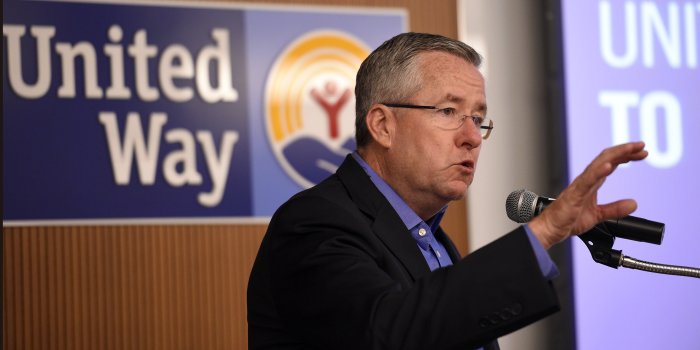By: James Piereson and Naomi Schaefer Riley – wsj.com – November 17, 2017
United Way CEO Brian A. Gallagher at a human-trafficking forum in Alexandria, Va., 2015. Photo: Nick Wass/AP Images for United Way Worldwide
The Trump administration has turned out to be a bonanza for the nonprofit world. Liberal groups like the American Civil Liberties Union and Planned Parenthood have reported great fundraising success since last year’s election. In addition, many large foundations have decided to direct hundreds of millions of dollars toward new ventures to combat the supposedly ill effects of administration policies. Though few conservatives will applaud the aims of these campaigns, the expenditures have ironically helped to demonstrate a core conservative principle: When government steps back, private money often fills the void.
A few leaders in the liberal philanthropic world saw this dilemma approaching. After the 2016 election, Caleb Gayle, a former program officer at the George Kaiser Family Foundation, argued in the Chronicle of Philanthropy that the nonprofit sector shouldn’t spend more to make up for gaps in government funding. Instead he counseled exercising “strategic restraint.” Why? “To many foundations,” he wrote, “it might seem cruel to resist calls to spend more . . . But if grant makers start to far exceed the 5 percent annual minimum, they will validate the conservative desire to strip money from government antipoverty measures.”
This summer, the Chronicle collected information on “foundation actions taken in direct response to Trump administration policies or more generally linked by grant makers to the current political environment.” As of August, total commitments exceeded $700 million, “not including those by groups that announced proportional increases in grant making but did not give dollar amounts.”
These grants include $375 million from the Bill and Melinda Gates Foundation for “responding to Trump administration plans to cut federal spending on international family planning”; $100 million from the Omidyar Network to “support investigative journalism, help citizens engage with government, and reduce hate speech”; and $35 million from the California Foundation, which is “shifting its entire grant-making budget to focus on access to health care for Californians, including immigrants; maintaining the social safety net for low-income residents; and preventing hate crimes.”
Between new money given to combat discrimination, climate change and “fake news,” and funds to provide for abortion and other liberal advocacy groups, liberal foundations are doing a great deal to make up for any reductions in government money going toward these causes. Moreover, according to the Chronicle, “the Ford and MacArthur funds said their grant-making strategies were already aligned with the challenges posed by the current political and economic environment.”
But mega-spending by billionaire family foundations is not exactly what most people, let alone conservatives, have in mind when they think about the private sector filling the void where government falls short. They think about churches running soup kitchens or the YMCA providing temporary housing for the homeless. They think about private citizens donating money and time to everything from foster-care agencies to drug-treatment centers.
While some liberal philanthropies help people who are genuinely in need, a great deal of their money has been diverted instead to political advocacy. At last year’s annual meeting of Independent Sector, one of the largest gatherings of nonprofit leaders in the country, Ellen Alberding, president of the Joyce Foundation, told a cheering audience, “foundations could and should be more aggressive on the advocacy front on the issues they really care about.” Brian Gallagher, chief executive of United Way Worldwide, expanded this message beyond foundations to nonprofits generally: “If you don’t have a policy strategy, then you don’t have a mission and purpose.” Philanthropy, in other words, is politics in a different guise.
While they would presumably argue that such advocacy brings benefits to those on the margins of society in the long run, it does not provide the direct and tangible benefits that improve the material, spiritual and intellectual lives of individuals right now. This is one reason why it is disappointing that the assets controlled by left-leaning foundations vastly outweigh those controlled by right-leaning ones. According to a Manhattan Institute report published earlier this year, left-leaning policy foundations such as Rockefeller and Carnegie control about $38.38 billion, compared with $7.41 billion for those that lean right, such as the Charles Koch and Earhart foundations.
Not only does this mean less long-term funding for, say, voucher programs that directly help low-income families; it means less support for all sorts of educational institutions and social-service groups that shun government funding. This trend coincides with the disappearance of small religious institutions in areas where they are most needed. Catholic parishes and schools in inner cities have been consolidated, some shutting their doors. Evangelical churches in Appalachia often find their pews empty as the young move away or abandon religious commitments. Efforts to address these trends are unlikely to find much sympathy at left-wing philanthropies.
The evolving focus of liberal philanthropy mirrors changes in the wider political landscape. In the past, liberal advocacy efforts were heavily focused on preserving funds for antipoverty programs. But that focus seems increasingly dated as support for a wide social safety net consolidates, to the point that existing programs are increasingly difficult to cut or even reform.
Liberal philanthropists today are absorbed in a network of new causes: abortion rights, climate change, income inequality, immigrant rights, regulation of the internet, the elimination of “hate,” and other social and identity-based projects. Without a counterbalance provided by right-leaning philanthropies, expect private money to flow even more asymmetrically toward ever more radical causes.
Mr. Piereson is a senior fellow at the Manhattan Institute. Ms. Riley is a senior fellow at the Independent Women’s Forum.
Source: Philanthropy Booms in the Trump Era—but It Also Gets Political – WSJ
 Listen Online
Listen Online Watch Online
Watch Online Find a Station in Your Area
Find a Station in Your Area










 Listen Now
Listen Now Watch Online
Watch Online
